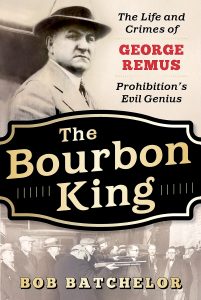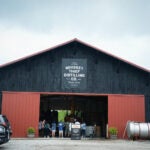
“The Bourbon King: The Life and Crimes of George Remus, Prohibition’s Evil Genius” by Bob Batchelor
One hundred years ago in 1919, Congress passed the Volstead Act giving teeth to Prohibition.
Booze operations continued illegally with names like Lucky Luciano and Al Capone, but none was more successful than George Remus. Remus was able to buy an empire of Kentucky distilleries, and hide the profits through his pharmacy operations, taking advantage of Prohibition, the Jazz Age and organized crime.
In 1890, George began work with his uncle’s pharmacy. He lied about his age on his application for a pharmacy license, and purchased a drug store at the age of 21. He acquired another and began launching “Remus” branded products, such as “Remus’ Liver Pills.”
In 1904, Remus received his law degree and established a legal office dealing with union and business operations. Known for his dramatic courtroom scenes, George defended several Chicago elite clients accused of murder. And even though they were convicted, their sentences were light instead of death.
George began an affair but was arrested for getting into a fistfight with the plumber in his mistress’ apartment. His wife divorced him, and afterwards he left Chicago and moved to a suite of rooms at a prominent Cincinnati hotel.
Volstead passed in 1919, but became law in 1920. George began to purchase distilleries in decline for a bargain as well as opened a pharmacy in Covington. It is known that Remus owned at least 12 distilleries and had a silent interest in many others.
The 1920’s were roaring for Remus and he was dubbed the “king of the bootleggers.” Remus’ activities were not unnoticed by the justice department who hired Mabel Walker Willebrandt as assistant attorney general, the highest-ranking female in federal government. Her duty was to enforce the Volstead Act, but the feds assumed she would pose no real threat to their casting a blind eye at Remus.
However, one of the Remus distribution drivers was stopped for a traffic violation and was found to be transporting a case of whiskey. He then told police of the wealthy men in Cincinnati delivering alcohol to 60 towns across the midwest. Remus was arrested and indicted on 3,000 charges of violating Volstead.
While George is dealing with prison, his new wife, Imogene, began an affair with a justice department investigator, Franklin Dodge. They plot to ruin Remus, and began by selling off his distilleries. Manuel Rosenberg, a newspaper artist with the Cincinnati Post said of Mrs. Remus and Franklin Dodge, that (Remus) “would go wild every time you mentioned it.”
A bitter feud resulted between the justice department and the bourbon kingpins, which led to murder and a “sensational trial of the century.” Remus was one of the first to claim a defense of temporary insanity.
Many said that “Remus was to bootlegging what Rockefeller was to oil.” His stepdaughter said that he often told her mother that he could get away with anything. Did he?
Legend says that Imogene Remus still haunts Eden Park. Some folks even say she runs wild and sobbing as though she hears footsteps behind her.
— Reviewed by Lizz Taylor, Poor Richard’s Books

“Kentucky Barns: Agricultural Heritage of the Bluegrass” by Carol Peachee
Carol Peachee worked with The Berry Center in Henry County researching this book. Wendell Berry’s daughter, Mary Berry, wrote the foreword of this gorgeous coffee table photography book. She commented that “there isn’t a town in Henry County that is not dead or dying. As I look back now, the first sign of this decay was the barns.”
Carol Peachee photographed these barns as a tribute to an agrarian past. In fact, Kentucky was fourth in the nation in the number of barns built prior to 1960. Barns housed tobacco, hay as well as horses and farm equipment. Flying into the Bluegrass Airport, I am always astounded by the beauty of the landscape with board fences dotted with barns. Most are framed timber barns using material that was readily available, but occasionally there were also made of stone or brick.
The tobacco buyout cast the shadow of disuse on many barns, and that has led to many of our barns disappearing or being allowed to collapse to the ground. The Kentucky Arts Council attempted to find a use for barns along highways by using them to feature heritage quilt patterns. The Tobacco Heritage Trail also used barns to raise awareness of Kentucky tobacco culture. The Kentucky Heritage Council surveyed our barns and have noted their architecture, tradition, historic values and aesthetics.
In Peachee’s photos you can imagine the silence of the interiors interrupted by farm workers discussing what needed to be done before the weather changed. The noise of machines is absent, replaced with hand tools carefully displayed, hay still being stored, and today possibly even hemp.
There are also photos of the horse barns of today, including Ashford Stud once a Hereford farm owned by E.H. Taylor now housing two Triple Crown winners, Justify and American Pharaoh with chandelier lighting and stone floors.
The Franklin County barns featured include one with the family cemetery attached, another with beautiful, vented barn doors, one with a 19th century V-notched single-crib log barn and an 18th century barn with a stone chimney attached suggesting that this barn was once a log house.
Peachee is an award-winning fine art photographer who has worked on a number of bourbon books. There are more than 400 full-color photographs including interior shots as well as exterior.
Mary Berry commented that “these photos remind us of the capacity of the human imagination … the result is beautiful.”
— Reviewed by Lizz Taylor, Poor Richard’s Books

“After Anna” by Lisa Scottoline
“A deliciously distracting thriller … Scottoline illuminat[es] the landing strip of revelations and truths in a deliciously slow and intense way.” —The Washington Post
If you like a novel with a twist that doesn’t follow the usual format, you will enjoy Scottoline’s 2018 domestic thriller, “After Anna.”
The book actually begins in the middle of the story. Dr. Noah Alderman is on trial for murder, and things are not looking good. The next chapter introduces us to Maggie, Dr. Alderman’s wife, and Anna, Maggie’s estranged daughter.
From here, the story takes a slow, arduous uphill climb, but don’t get discouraged if the plot seems to drag a little in the middle. By the final third of the book, the twists and turns will have your mind racing to keep up. Some reviewers say the ending is too unrealistic. I, on the other hand, believe that is why we call it fiction.
Lisa Scottoline is the New York Times bestselling author of 32 novels including her latest work, “Someone Knows” (published in April 2019). I hope you enjoy this and other great selections by Scottoline that are available at the library!
— Reviewed by DeAnna Parker, Paul Sawyier Public Library

“The Wife” by Alafair Burke
“Written by a former prosecutor with a genius for plot, this thrill ride of a novel takes a hard look at loyalty and the violence a secret can cause — especially when that secret involves a revered public figure accused of rape.” — O, The Oprah Magazine
Angela Mullen is a caterer at the Hamptons when she meets Jason Powell, a charismatic economics professor who surprises her by asking her to marry him soon after they are introduced.
He brings Angela and her son, Spencer, to Manhattan to live, and soon after writes a bestselling book on economics. Then come the allegations of sexual harassment by a young woman he supervises. Angela thinks it will all blow over but then another woman steps forward.
When one of the accusers disappears, Angela must decide how far she will go to protect herself and the ones she loves.
Alafair Burke is the bestselling author of 18 crime novels. She is the daughter of novelist James Lee Burke.
— Reviewed by Paul Sawyier Public Library










